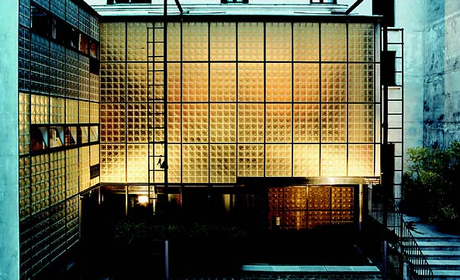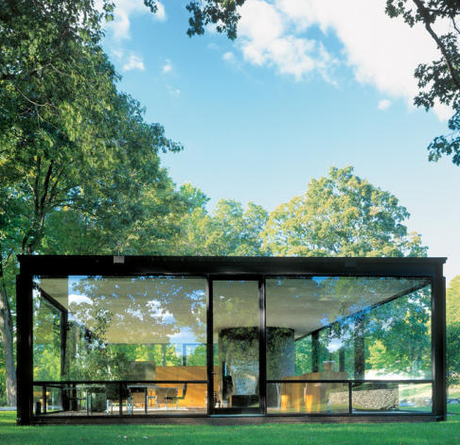Confidence, and a seasoned designer, are keys to pulling off life in a glass house. Whether an outsider’s view is obscured or the space bares it all, many understandably opt for remote destinations and vacation homes. Let’s take a stroll through a few iconic designs:

Photo via The New York Times.
The Maison de Verre, constructed from 1928 to 1932 in Paris, France was a collaboration among interior and furniture designer Pierre Chareau, Dutch architect Bernard Bijvoet, and craftsman metalworker Louis Dalbet. Dr. Jean Dalsace and his wife, the new owners, were unable to evict the woman who lived upstairs. Instead, Chareau created the dwelling below her apartment. The glass space housed Dr. Dalsace’s medical office as well as his home. What I found most interesting is that depending on which doorbell you rang, you could only enter the office or the private residence. This was done by a rotator screen at the bottom of the staircase (So innovative!). The stairs to the residence were hidden from medical clients during the day and illuminated at night. The interior design combined industrial elements with a more traditional style. Towards the street side the home has glass bricks that let light stream in, but obscure the view, ensuring the home is completely private.

Photo via Matthew Langley.
Philip Johnson built this modern home with transparency in mind, sticking to economy and a lack of clutter. Only the essentials were included. The home is beautifully integrated into the scenery. The glass house was built on top of a hill on a 47 acre estate in New Canaan, Connecticut. All furniture was designed by Mies van der Rohe, a famous architect in his own right. Johnson transferred the furniture from his New York City apartment, also built by Rohe, to the glass house. Mies even created the daybed for the home.

Photo via Art According to Cary.
In 1951 Mies van der Rohe once again used his skills to erect the Farnsworth House, located on the Fox River in rural Northern Illinois. The home is considered his expression of modernist ideals and is almost Puritanical in its uncluttered and simplified interior. The isolated location allowed for complete transparency. The rectangular home appears to float above ground, suspended by white concrete steel columns. There is an interplay of nature and architecture and the landscape plays an integral role in Rohe’s aesthetic. The home was built as a vacation home for Dr. Edith Farnsworth.
Unfortunately Dr. Farnsworth and Mies had a tenuous relationship. What Mies saw as a lack of extraneous elements, Dr. Farnsworth viewed as an annoying lack of closets. Farnsworth had screens erected on the upper deck and a wardrobe built complete with closets. Mies took this to heart and believed it impeded the view and his vision. The two later went to court when Farnsworth refused to pay the remainder of the construction costs. Mies won the battle in court. (I think I am siding with Edith in regards to this issue – us girls must have amazing closets! I prefer mine a mixture of glam and sophistication, with great lighting, a crystal chandelier, a built-in vanity, laundry hamper, and lots of shoe storage will do it for me!!)

Photo via Enthralld.
Think glass houses have seen their demise? Architect and designer Hiroshi Nakamura begs to differ. His optical glass home in the heart of Hiroshima is enclosed around a garden of foliage and trees. The picture of his glass house actually inspired this post. The glass blocks only allow light and air to flow through while revealing a glimpse of the garden inside or a waterfall-like form depending on the light in a kaleidoscope of views. Comprised of 6,000 glass blocks held together by stainless steel, the sound proof space creates an atmosphere of tranquility despite the bustling street below. The wood-paneled garage on the first level leads to a garden on the second level, then the living room and dining area, and finally the main living area that opens into the glass garden.
Would you be willing to live in a glass house? What features or closets (: are a must for your lifestyle?
